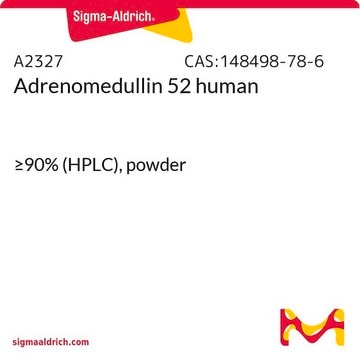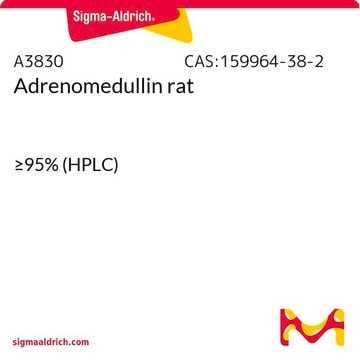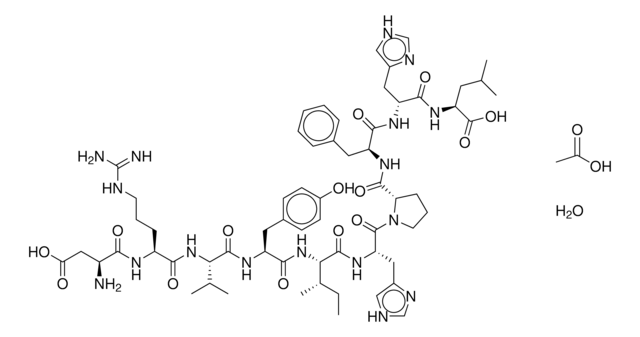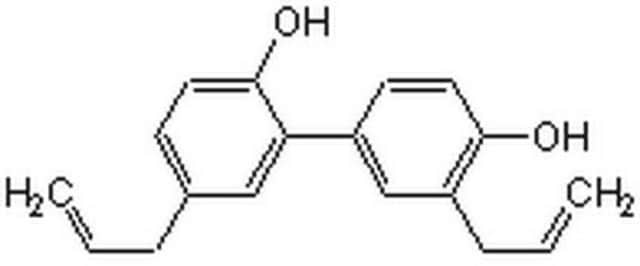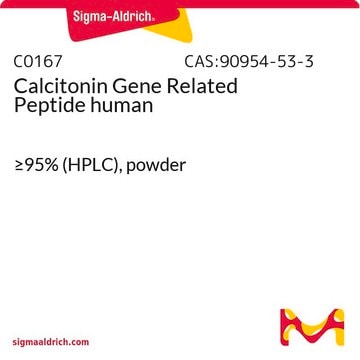A3832
Adrenomedullin Fragment 22-52 human
≥97% (HPLC)
Zaloguj sięWyświetlanie cen organizacyjnych i kontraktowych
About This Item
Wzór empiryczny (zapis Hilla):
C159H252N46O48
Numer CAS:
Masa cząsteczkowa:
3575.98
Numer MDL:
Kod UNSPSC:
12352209
NACRES:
NA.26
Polecane produkty
Powiązane kategorie
Amino Acid Sequence
Thr-Val-Gln-Lys-Leu-Ala-His-Gln-Ile-Tyr-Gln-Phe-Thr-Asp-Lys-Asp-Lys-Asp-Asn-Val-Ala-Pro-Arg-Ser-Lys-Ile-Ser-Pro-Gln-Gly-Tyr-NH2
Działania biochem./fizjol.
Adrenomedullin Fragment 22-52 [ADM22-52] is used as an adrenomedullin (ADM) receptor antagonist to study the functions and mechanism of action of ADM signaling. ADM(22-52) is used to differentiate adrenomedullin binding sites in various cells and tissues.
Kod klasy składowania
11 - Combustible Solids
Klasa zagrożenia wodnego (WGK)
WGK 3
Temperatura zapłonu (°F)
Not applicable
Temperatura zapłonu (°C)
Not applicable
Środki ochrony indywidualnej
Eyeshields, Gloves, type N95 (US)
Certyfikaty analizy (CoA)
Poszukaj Certyfikaty analizy (CoA), wpisując numer partii/serii produktów. Numery serii i partii można znaleźć na etykiecie produktu po słowach „seria” lub „partia”.
Masz już ten produkt?
Dokumenty związane z niedawno zakupionymi produktami zostały zamieszczone w Bibliotece dokumentów.
Takahisa Ishikawa et al.
Oncogene, 22(8), 1238-1242 (2003-02-28)
Since it is reported that adrenomedullin (AM) upregulated by hypoxia inhibits hypoxic cell death, we examined the effects of AM antagonist (AM C-terminal fragment; AM(22-52)) on the growth of pancreatic cancer cells. We, for the first time, demonstrated that AM
Agnieszka Ziolkowska et al.
International journal of molecular medicine, 11(5), 613-615 (2003-04-10)
Adrenomedullin (ADM) and its receptors are expressed in the adrenal cortex, where ADM is currently known to inhibit agonist-stimulated aldosterone secretion from zona glomerulosa (ZG), without affecting either basal aldosterone release or the secretory activity of zona fasciculata-reticularis (ZF/R) cells.
Christian Juaneda et al.
European journal of pharmacology, 474(2-3), 165-174 (2003-08-19)
The existence of specific adrenomedullin receptor binding sites was investigated using the agonist peptide fragment [125I]human adrenomedullin-(13-52) in rat brain, lung and vas deferens homogenates. Saturation-binding experiments suggest that [125I]human adrenomedullin-(13-52) binds to an apparent single population of sites with
Jing Hui Yang et al.
Regulatory peptides, 158(1-3), 19-25 (2009-06-16)
Intermedin (IMD) is a novel peptide related to calcitonin gene-related peptide (CGRP) and adrenomedullin (ADM). Proteolytic processing of a larger precursor of IMD yields a biologically active C-terminal fragment IMD(1-53). We aimed to observe the cardioprotective antifibrotic effects of IMD(1-53)
Benjamin Uzan et al.
Journal of cellular physiology, 215(1), 122-128 (2007-10-18)
Adrenomedullin (ADM) has been shown to mediate multifunctional responses in cell culture and animal system such as regulation of growth and apoptosis. ADM stimulates the proliferation of osteoblasts in vitro and promotes bone growth in vivo. The ability of ADM
Nasz zespół naukowców ma doświadczenie we wszystkich obszarach badań, w tym w naukach przyrodniczych, materiałoznawstwie, syntezie chemicznej, chromatografii, analityce i wielu innych dziedzinach.
Skontaktuj się z zespołem ds. pomocy technicznej